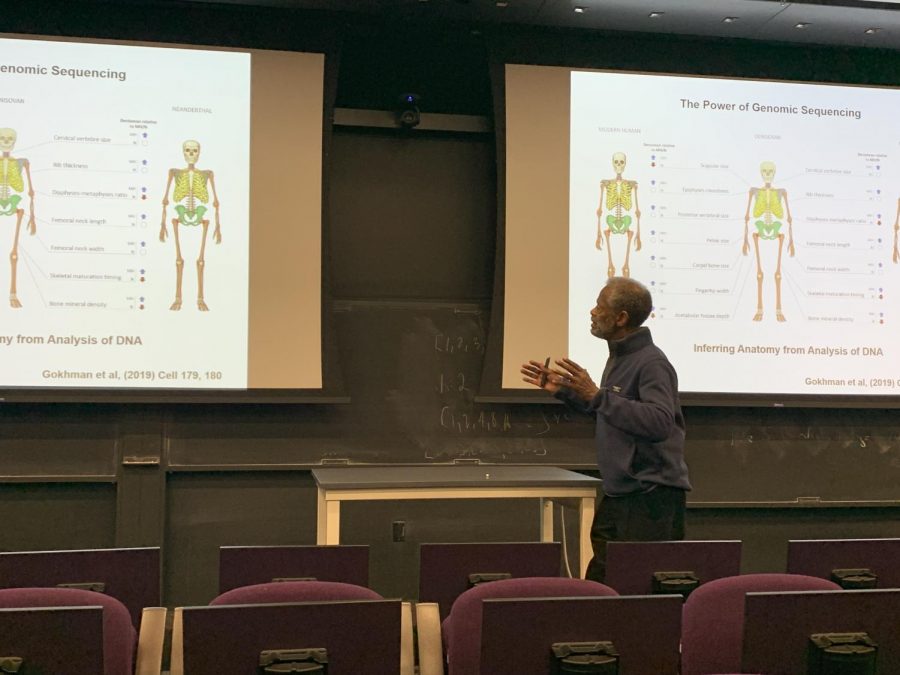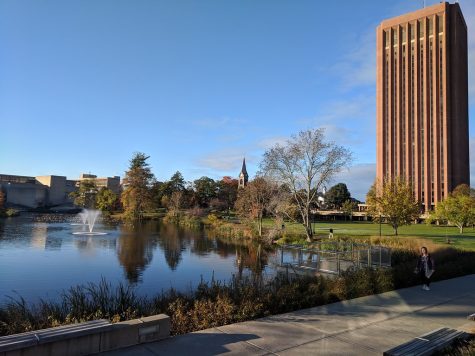Race isn’t so black and white
Professor Richard Goldsby of Amherst College hosts a powerful lecture about the roots of race and racism.
Professor Goldsby in the midst of his lecture
AMHERST – Why do we have different races? Richard Goldsby, a biology professor at Amherst College, lectures to an attentive audience last Tuesday about the DNA-entangled tale of race, and how racism was a result of its inception.
“Human races are hybrids. They’re certainly not all biology […] They’re also not all social constructs,” says Goldsby.
Socially, we’re all categorized into a racial group depending on our physical attributes. These racial groups vary depending on what country or society you live in. Someone who’s identified as black in America may be considered a different race in Brazil.
Goldsby argues that race isn’t a meaningless title given to us by society. When referring to a Stanford experiment conducted in the mid-2000s, scientists found out the biological genomes of people from varying races correlated with the racial groups assigned to them by their governing society. A resounding 99.8% of subjects matched their racial group.
Goldsby explains, with the scientific developments of prehistoric DNA sequencing (the analysis of DNA strands), we can now trace the biological origins of race and how we became separated into varying racial groups.
The oldest known human fossil, a roughly estimated 300,000-year-old human skull, was found in Morocco. This along with many other ancient human fossils has led scientists to believe the human species was born in Africa.
Goldsby claims race developed once these early humans began to migrate to regions of Europe and Asia. These humans bred with Neanderthals and Denisovans, who were Homosapien sub-species native to Europe and Asia. This interbreeding produced humans with varying genetic characteristics, such as different skin and eye colors. Eventually, it became difficult for humans from different regions to breed with one another. This developed the first human societies.
“You got global populations distinguished by their own cultures,” says Goldsby. “Had there been people around to argue about the issue of race, some people would have accused some of the populations of being racist.”
The earliest examples of racism can be traced back to this period. It was difficult for humans to travel hundreds of miles to breed with another population. It was also societally frowned upon to breed with humans that looked different from themselves, according to Goldsby. These physical and social barriers crafted what Goldsby calls “Breeding Populations,” where humans would exclusively breed within their racial group.
Race’s first developments may have lasted for a long or short time, this all depends on whether or not the breeding population stayed intact through intermixing. These earlier races may have also faced extinction.
“The races that are here today aren’t necessarily the races that’ll be here tomorrow. The races today may not have been here yesterday,” says Goldsby.
Goldsby goes on to discuss the genetic differences in race in terms of physical attributes, behavior and intelligence.
“Some races generate taller people,” says Goldsby.
Race and genetics are intertwined. Certain races produce people with narrower shaped heads, some races produce people with longer arms. Physical attributes correlate with racial groups.
What about mental attributes? Are certain races more intelligent than others?
Goldsby debates the white-black intelligence argument that has been discussed in social circles, research papers and experiments for over a millennium. He attributes the work of Arthur Jensen, a doctor in psychology, and his controversial IQ comparison study where he found the average IQ levels of black Americans to be 15 points less than white Americans. This study would go on to be scrutinized and debated for years on end.
An identical study was done between non-Jewish white Americans and Jewish white Americans. The results were similar; white Americans of Jewish descent had a 15 point higher IQ score than their non-Jewish counterparts. Goldsby asks why we see little discussion over Jewish white people being more intelligent than non-Jewish white people:
“You don’t see it, because there’s not a profound achievement gap between those two populations.”
The idea of “Achievement Gaps” was introduced into the discussion. Goldsby defined it as a recognition of a race’s accomplishments and contributions in any given field. Jewish and non-Jewish white Americans have accomplished many things in America, mostly due to their historical privilege, oppressiveness and dominance granted to them by the forefathers of this nation. Black people have been historically underprivileged, discriminated against and oppressed in this country, which is why the achievement gap is wider in comparison.
“There was a time where people truly believed that blacks weren’t smart,” said Goldsby.
Goldsby talks about how in the past most people believed black people to be linearly athletic. Black people weren’t perceived as intelligent enough to play more intricate sports like baseball or to be the quarterback in football (shoutout to Patrick Mahomes). Goldsby states the reason why this conversation isn’t brought up anymore is because the achievement gap of black people in sports has diminished.
“Those of us who are black, we are going to have to fight this battle. We’re not going to win it by writing books about it. We’re not going to win it by debating back and forth…. This argument about black-white IQ differences isn’t going away until the achievement gap goes away,” said Goldsby.
An audience member asks Goldsby when the achievement gap will be closed. What dictates when people of color have done enough? There are a large number of black people who have made extraordinary contributions to intellectual fields of study: Sojourner Truth, Thurgood Marshall, Garrett Morgan, and W.E.B. DuBois, just to name a few.
“To some extent, it’s already happened,” said Goldsby.
Goldsby recalls black recognition in the TV, music and writing industries as examples of black achievement gaps closing.
“I see the gap narrowing and even going away in many areas. I’ll tell you a place where I’ll like to see that happen,” said Goldsby.
Goldsby then goes on to discuss his early admiration of Astronomer Carl Sagen, and how proud he is of Neil deGrasse Tyson carrying on Sagen’s legacy once he passed.
“I need to see more Neil deGrasse Tysons. I need to go to more scientific meetings and see more people carry around an afro comb the way I do. We need more,” exclaimed Goldsby.
I asked Goldsby what influenced his passion and drive to study the biology of race.
“Growing up in the United States. Race has been a central part of my life since I was 4 or 5 years old,” he replied.
The segregated system that he grew up in and how overcoming each racist barrier that impeded his ability to study academics made him more intrigued to study the biology of race, he tells us.
The skin color of the first Homosapiens was most likely black. Black people should take pride in knowing their skin resembles that of the first human to ever walk the earth.
Email Tristan at [email protected]












